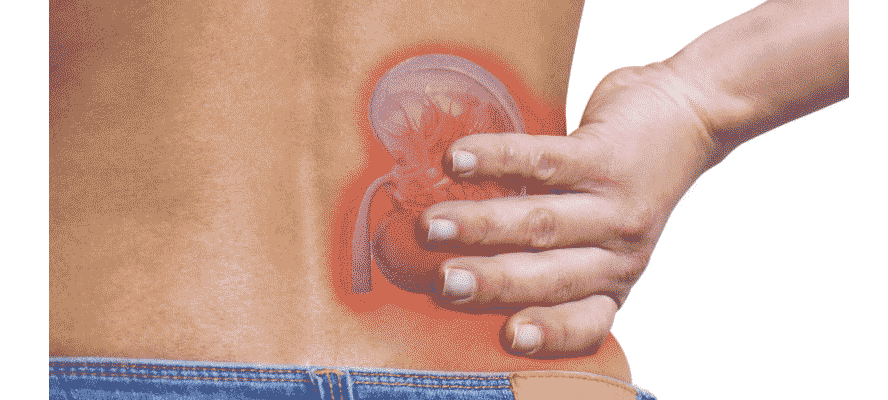Pain, Causes and Treatment for Kidney Stones
Posted By HealthcareOnTime
Posted on 2021-06-25
It is a well-known fact today that kidney stones may cause cloudy urine. However in 90% of cases it is the pain of the stones that may lead you to see a doctor more quickly than the cloudy urine. Kidney stones are not fun, in fact, some people have described passing a kidney stone as the worst pain they have ever experienced.
Recalls one patient, 'The first time I had a Kidney stone I thought I was going to die. My wife and I were starting to eat dinner and I just collapsed in pain on the floor (no not from her food). Not knowing what the feeling was, I assumed the worst and thought I had appendicitis. The pain was a sharp throbbing pain in my left side (for those of you who don't know the appendix is on the right side). I swore to my wife my appendix had burst and after several minutes of bickering, crying and nausea I insisted on going to the hospital. Every bump in the road sent shocks of pain through my entire body. Once in the emergency room the nurse was able to identify my symptoms immediately as a Kidney Stone. Several painful hours later I still had not passed the stone. The painkillers (shots) had kicked in but the uncomfortable feeling and pressure was still there. After another hour they sent me home with a straining device and a big bucket to capture you know what for the next 24 hours.
The feelings I experienced were of not only sharp pains but also the massively uncomfortable feeling of pressure. You know you have to go, the feeling is familiar, but something is blocking the path. You will feel this pain from deep in your side (the kidney) all along the path until it exits. This time it took me another 24 hours or so to pass the stone. Painkillers can manage the pain, but the mental anxiety can be very distressing.
Urinary stone constitutes one of the commonest diseases in our country and pain due to kidney stones is known as 'worse than that of labour pain'. The disease is as widespread, particularly in countries with dry, hot climate. These "stone belt regions" of the world are located in countries of Middle East, North Africa, the Mediterranean Regions, North Western state of India and Southern State of USA and areas around the great lakes.
In India, approximately 5 -7 million patients suffer from stone disease and at least 1/1000 of Indian population needs hospitalization due to kidney stone disease. In India, the "stones belt" occupies parts of Maharashtra, Gujarat, Punjab, Haryana, Delhi and Rajasthan. In these regions, the disease is so prevalent that most of the members of a family will suffer from kidney stones sometime in their lives. Surgery for removal of urinary stones forms one of the commonest operations in hospitals in these regions.
A recent survey shows that there has been rapid increase in the number of people suffering from Kidney stones. One in every 20 people develops a kidney stone at some point in their life. Men are affected more frequently than women. The prevalence of kidney stones begins to rise when men reach their 40s, and it continues to climb into their 70s.
Signs & Symptoms of Kidney stones
- Restlessness
- Nausea
- Urinating more often than usual
- Pain during urination (dysuria)
- Blood in urine (hematuria)
- Lower backache
- Discoloured or foul-smelling urine
However, these symptoms of kidney stones may not occur unless
the stone starts passing through the ureter.
Causes of Kidney stones
- Lack of water
- Elevated acidity in urine
- High intake of calcium and vitamin D supplementation
- Food with high sodium content
- Urinary track infections (UTIs)
- Hyperparathyroidism
- Crohn's disease
Treatment of Kidney stones
Not all types of kidney stones require invasive treatment. Most
of the stones are so small that they easily pass through the ureter,
while others (based on the size, number and location of the stone)
need surgical procedures like,
Lithotripsy - Breaking of kidney stones using ultrasound shock waves.
Tunnel surgery - A small incision in the back is performed for removal
of kidney stones.
Ureteroscopy - Thin rigid telescope used to track kidney stones.
Conditions such as acute kidney pain, UTIs are treated with pain
killers and antibiotics, respectively.
Can kidney stones be prevented ?
The best preventive measure one can take is to keep the body
well hydrated; say increase the water intake to 3-4 litres a
day, which will help one increase the flow of urine and proper
flushing of kidneys. Including oxalate-rich food (spinach, beets,
nuts and nut butters etc.) in diet may significantly lower the
risk of kidney stones. Moreover the phrase - when life gives you
Stones, make a lemonade! is apt to be followed because citric foods
will help one prevent binding of calcium with other components in
urine, thus avoiding stone formation. Lowering the calcium intake
won't solve the problem of stones as it will increase the level of
oxalates in the body. So, balance between calcium, oxalate and
sodium is what will keep the kidneys stone-free.
All said and done, assessment of kidney health at any time in life won't
be harmful at all. Given an easy access to Diagnostic Test, it is time we
care for our kidneys, as they care for our body's filtration.
People who have already had more than one kidney stone are prone to develop more stones. Once a kidney stone forms, the probability .You know you have to go, the feeling is familiar, but something is blocking the path. You will feel this pain from deep in your side (the kidney) all along the path until it exits. that a second stone will form within five to seven years is approximately 50%.
A family history of kidney stones is also a risk factor for developing kidney stones. Stones are less common in children than in adults, although the number of children who develop stones is unclear. Most children who develop
kidney stones have an underlying condition that increases their risk of stones, although some children develop a stone for unknown reasons
Book Kidney Function Blood Test





















































